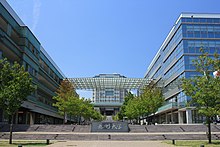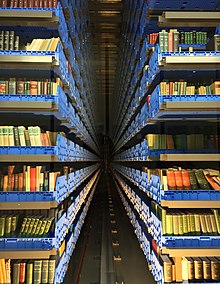Kyushu University
| Kyushu University | |
|---|---|

|
|
| founding | 1911 |
| Sponsorship | state (University Corporation) |
| place | Fukuoka |
| president | Chiharu Kubo |
| Students | 18,393 |
| Employee | 4,049 |
| Annual budget | 106.471 billion yen (2006) |
| Website | www.kyushu-u.ac.jp (engl.) |
The University of Kyūshū ( Japanese 九州 大学 , Kyūshū daigaku , short Kyūdai 九大 ) is one of the most prestigious state universities in Japan . The new main campus is located in Motooka, on the edge of the western outskirts of Nishi-ku of the city of Fukuoka in the prefecture of the same name on the island of Kyūshū .
history
The history of the University of Kyūshū (also Kyūshū University) goes back to a medical school called Sanseikan ( 賛 d, that is, "House of Life Praising"), which the Princely House of Fukuoka ( Kuroda - han ) founded in 1867 as part of the nationwide boom in Western medicine had founded. A few years later, in the meantime the rule of the Tokugawa had collapsed and the new Meiji government decided to take over German medical education, this school opened a hospital in 1874, which was renamed the Fukuoka Hospital in 1877.
In 1903 the Fukuoka Medical School was set up as a branch school of the Kyōto Imperial University ( 京都 帝国 大学 福岡 医科大学 , Kyōto teikoku daigaku Fukuoka ika daigaku ) by a government decision and the Fukuoka Hospital was connected to it as a clinical center. In 1911 these institutions went to the Imperial University of Kyūshū ( 九州 帝国 大学 , Kyūshū teikoku daigaku ). The young university had only two faculties (engineering and medicine) until 1919. This was followed by the Faculty of Agricultural Science (1919), Law and Humanities (1924) and Natural Sciences (1939). As one of a total of seven imperial universities, the university enjoyed strong financial and political support from the state.
In May and June 1945 during the Pacific War , anatomical experiments ( vivisections ) were carried out on eight American prisoners of war in the medical faculty . These events were later processed by Endō Shūsaku in the novel Sea and Poison ( Umi to dokuyaku , 1958).
In 1947 the university was renamed Kyūshū State University, two years later the former Fukuoka High School ( 福岡 高等学校 , Fukuoka kōtō gakkō ) was incorporated as a College of General Education, followed in the same year by the Kurume Technical Center ( 久留 米 工業 専 門 学校 , Kurume kōgyō) semmon gakkō ). In 2003, the Kyūshū University of Art and Technology ( 九州 芸 術 工科 大学 , Kyūshū geijutsu kōka daigaku , English Kyushu Institute of Design ) became a faculty of design. In the course of the university reforms, the university, like all state universities, was transferred to a public corporation (University Corporation). Since the 1990s, the faculties and institutes have been gradually relocated to a new campus in the west of the city of Fukuoka, which was completed in September 2018. The campus of the Faculties of Medicine, Dentistry and Pharmacy has remained in the city center (Maidashi) because of the role of the clinics in providing health care to the population.
The university pursued an opening and internationalization of its student body and faculty from an early stage. In 1984 the first permanent tenure of a foreign professor at a state university took place here. The proportion of foreign teachers is now around 5%. In addition to several ten to twelve month programs, there are also undergraduate and graduate programs in English for an international student body.
Faculties
- Ito campus (in Motooka, Nishi-ku , Fukuoka, 33 ° 35 ′ 46.6 ″ N , 130 ° 13 ′ 8.3 ″ E ):
- Maidashi Campus (in Maidashi, Higashi-ku, Fukuoka, 33 ° 36 ′ 37.7 ″ N , 130 ° 25 ′ 1 ″ E ):
- Ōhashi-Campus (in Shiobaru, Minami-ku , Fukuoka, 33 ° 33 ′ 39.9 ″ N , 130 ° 25 ′ 48.5 ″ E ):
Well-known graduates
- Hashimoto Hakaru (1881-1934), medical doctor
- Robert T. Huang (* 1945), founder and first President of SYNNEX Corporation
- Masashi Kishimoto (* 1974), comic artist
- Tetsu Nakamura (1946–2019), doctor, development worker in Afghanistan
- Junko Tabei (1939–2016), mountaineer
- Kōichi Wakata (* 1963), astronaut
- Hirofumi Yoshimura (* 1975), politician
Well-known teachers
- Inada Ryūkichi (1874–1950), physician, pioneer of Japanese cardiology and oncology
- Katsurada Fujirō, parasitologist, discoverer of Schistosoma japonicum
- Kubo Inokichi (1874–1939), pioneer of ear, nose and throat medicine
- Kuwaki Ayao (1878–1945), physicist, first Japanese proponent of Einstein's theory of relativity
- Ōmori Harutoyo (1852–1912), physician, first president
- Shinkai Seiji (* 1944), chemist
- Tawara Sunao (1873–1952), pathologist, discoverer of the atrioventricular node
- Takeuchi Rizō (1907-1997), historian (Kyūshū Univ. From 1948 to 1959)
See also
Web links
- Official website (Japanese and English)
- German partner institutions
Individual evidence
- ↑ http://www.kyushu-u.ac.jp/en/university/president/
- ^ Student Enrollment. (No longer available online.) Kyūshū University, archived from the original on November 28, 2009 ; Retrieved December 19, 2009 . Info: The archive link was inserted automatically and has not yet been checked. Please check the original and archive link according to the instructions and then remove this notice.
- ^ University Staff. (No longer available online.) Kyushu University, archived from the original on November 29, 2009 ; Retrieved December 19, 2009 . Info: The archive link was inserted automatically and has not yet been checked. Please check the original and archive link according to the instructions and then remove this notice.
- ^ University budget, country, location. (No longer available online.) Kyushu University, archived from the original on April 18, 2009 ; Retrieved December 19, 2009 . Info: The archive link was inserted automatically and has not yet been checked. Please check the original and archive link according to the instructions and then remove this notice.
- ^ New Campus. Retrieved July 4, 2019 (jpn).
- ^ Website of the International Affairs Department




